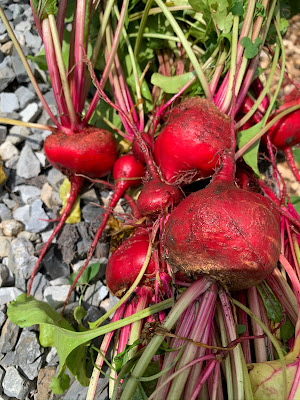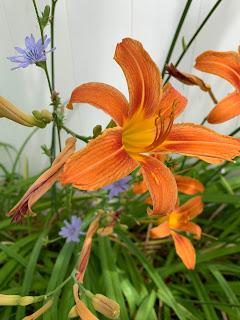By Anastazja Kolodziej
This Polish soup,
called botwinka, uses both the beets and the greens (chard) that come from a beet
plant—so if you’ve recently pulled some beets from your garden, you already
have the main ingredients for the soup! Here is the bountiful beet harvest from our community garden plot.
Note: This recipe
makes 10-12 bowls, which was enough for one dinner for 5 people.
Ingredients:
·
4 whole carrots,
peeled and chopped
·
8 medium beets,
chopped
·
1 pound chard, chopped
·
4-5 pounds potatoes,
peeled and cut into bite-sized pieces
·
5 cloves of garlic,
cut into quarters
·
2 bay leaves
·
2 vegetable stock
cubes
·
1.5 tablespoons
salt
·
Pepper, to taste
·
4 tablespoons heavy
cream, and more to taste
·
Egg (optional)
Prep:
·
Remove chard from the
beets, washing everything thoroughly
·
Cut chard (stem and
leaves) into bite-sized pieces
·
Peel and chop carrots
and potatoes
·
Chop beets
Cooking:
·
Boil water with bay
leaf, garlic, salt and vegetable stock cube
·
Add chopped carrots
and cook for 10 minutes
·
Add chopped beets and
cook until soft, approximately 15 minutes
·
Add chopped chard and
potatoes. Cook until potatoes are soft, approximately 20 minutes
·
Turn the stove off,
add cream and sprinkle the soup with pepper, to taste. I added about 4
tablespoons of cream into the pot and served the soup with cream on the side so
people could add more as they desired
·
Optional: This soup can be served with an egg (hard-boiled or
sunny-side-up) on top of the bowl
Optional: Sprinkle
fresh dill on top
"Savory Sunday" is a weekly summer blog series with seasonal recipes from the garden.
About the Author:
Anastazja Kolodziej is a rising senior at the University of Maryland, double majoring in multiplatform journalism and the classics (Ancient Greek and Latin). On campus, she serves as an assistant managing editor at The Diamondback.




























